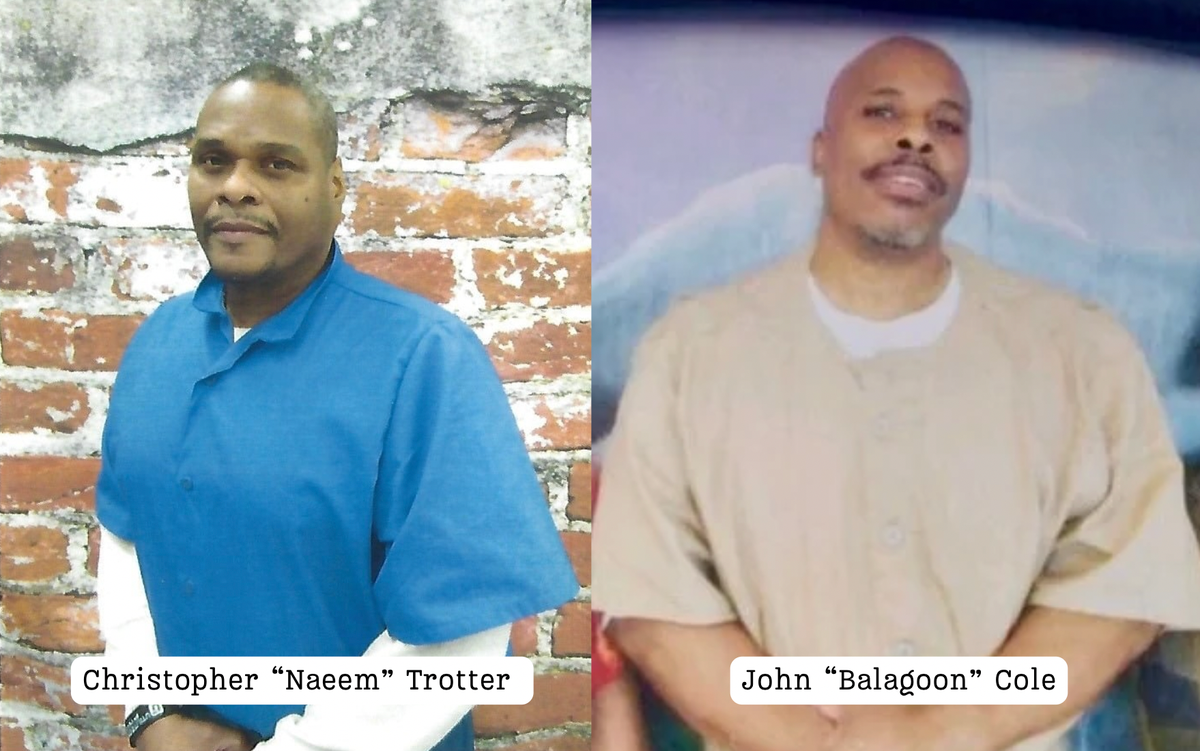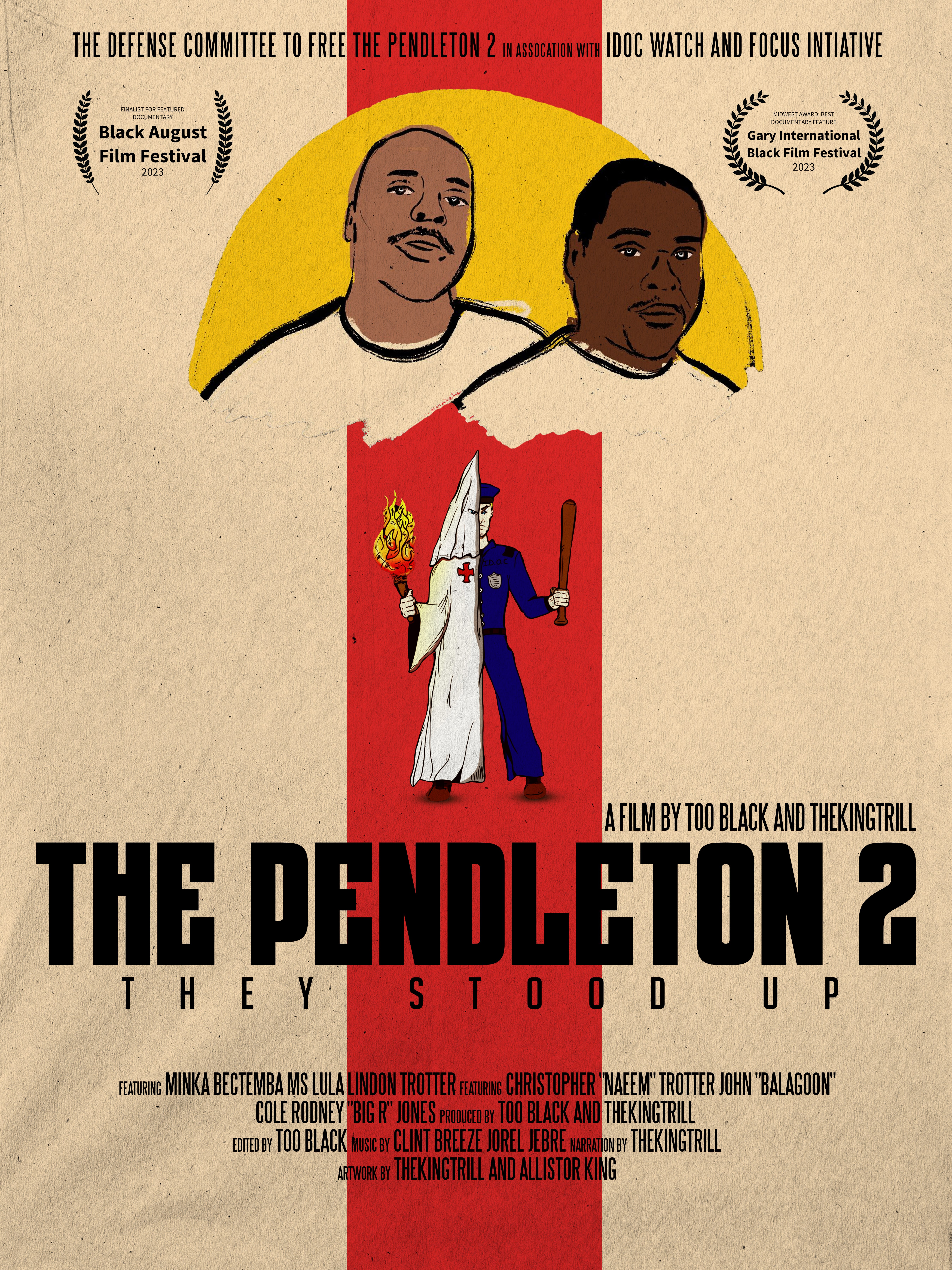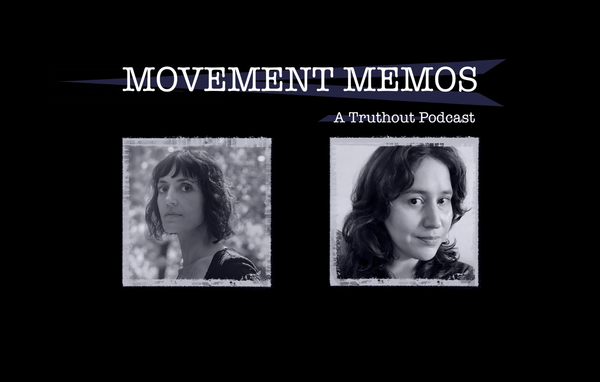“You're Next”: The Attica of Indiana and the Pendleton Two
"The Sons of Light were a guard gang that was a Ku Klux Klan splinter group," says Too Black, a Pendleton Two Defense Committee organizer.

On February 1, 1985, Christopher “Naeem” Trotter and John “Balagoon” Cole took action to save another man’s life. Trotter, Cole, and the man they hoped to save were all imprisoned at Pendleton Correctional Facility in Pendleton, Indiana. A white supremacist gang of prison guards known as the “Sons of Light” had just brutally beaten a man named Lincoln Love. Love was a “jailhouse lawyer,” which is an imprisoned person who is well-versed in the law and often helps other imprisoned people with their legal filings. Love was widely liked and admired by his peers in the prison. Believing that Love would die without assistance, Cole and Trotter confronted guards and demanded safety for Love. As the situation escalated, Cole and Trotter were forced to defend themselves and ultimately staged a takeover of the prison. Love survived the day and lived until 2020 when he died of COVID while still incarcerated.
For their efforts, Trotter and Coal received heavy prison sentences and served decades in solitary confinement. In March of 2023, Trotter told journalist Victoria Law that he did not regret his efforts to save Love:
“I spent decades in solitary confinement, in a windowless cell 23 hours a day, asking myself, ‘If I had to do it all over again, would I [have] sacrificed my freedom, plans to take care of my beloved mother, and be a present father to my daughter?’”
Then he answered his own question. “I would have done the same thing and [come] to the defense of a fellow human being who could not defend himself from the savage beating by racist prison guards.
While the story of the “Attica of Indiana” was largely forgotten by people who do not live or work in the Indiana prison system, a determined group of organizers have been rallying to free Cole and Trotter. In the spring of 2022, a defense committee was formed to raise awareness about Cole and Trotter’s cases and to advocate for their release. Defense committees are organized groups that focus on supporting and working to free a criminalized person or a group of criminalized people. I recently spoke with Too Black, an organizer with the Defense Committee to Free the Pendleton Two, about the largely forgotten history of the “Attica of Indiana” and why it’s time to bring Cole and Trotter home.
Kelly Hayes: Can you tell us what happened on February 1, 1985 at Pendleton Correctional Facility and why those events have been characterized as the “Attica of Indiana”?
Too Black: There was a prisoner by the name of Lincoln Love, who was known throughout the prison, particularly to the prisoners themselves, as a jailhouse lawyer. He had gotten 30 or 40 dudes out of prison, and was somebody that folks really looked up to. He was targeted by a gang of guards within the maximum restraint unit. The guard who normally worked that unit did not come into work that day. The guards on-duty strip searched everyone in the unit multiple times. Then, they targeted Lincoln Love. They went into his cell. They beat him with billy clubs while he was handcuffed until he was bloody and he was unconscious. Then they dragged him out of his cell, for everyone else to see, and told the surrounding prisoners, “You're next.”
This was someone the prisoners admired, so when they saw him like that, they shouted and spread the word throughout the [prison] population. So, from within the maximum restraint unit, they got word to other prisoners that this was happening. John “Balagoon” Cole and Christopher “Naeem” Trotter believed that Love was dying, and that someone had to intervene. First, they went to the captain's office, where they thought Love was still being beaten, to see what was going on.
When they went to investigate, they went peacefully. But they were met with violence and aggression from the guards. They had to fight their way out of that. Again, this is Christopher “Naeem” Trotter and John “Balagoon” Cole. Once they fought their way out of that, they got chased through the prison. They were still looking for Lincoln Love to see what happened, as they were getting chased by all these guards. Eventually, they had to fight for their lives again, because the guards were talking about killing them. They took a few hostages and went inside Cell House J, and then took over the prison for about 15 hours. They had a series of demands, including getting some cleaning supplies, more recreational time, and more Black staff. They were demanding a general improvement of conditions because, again, this was a pretty heinous facility even by prison standards.
The National Guard was called in, all kinds of police were called in, but they negotiated, and no one died during this takeover. Christopher “Naeem” Trotter and John “Balagoon” Cole were taken back to their cells. Journalists followed them, which had been one their demands, since they knew they’d be killed after the takeover, if the media wasn’t there. The reason people called it the “Attica of Indiana” is, obviously, there’s a similarity in that a prison was taken over, but also, the story is used to this day to keep prisoners in line. Inside the Indiana prison system, the takeover and the punishment that followed are still remembered by guards and prisoners.
KH: Who are the Sons of Light?
TB: A guard by the name Michael Richardson, who was at work during the uprising, testified that the Sons of Light was a KKK splinter group that existed amongst the guards. The group’s membership included lieutenants, sergeants, et cetera, so not just the low level guards. It was a group that many guards joined. He talked about how his own kids were babysat by some of the other guards’ families, so the kids used to play with the klan robes.
They had rituals that were similar to the KKK. That's how they would recruit people. They would leave all kinds of literature around the prison to encourage people to join. It wasn't something that guards were trying to hide from each other.
Obviously, this was a racist group, this was a brutal group, and this is pretty much the group that ran the prison according to Michael Richardson's testimony. On the day that Lincoln Love was targeted, this was the group that targeted him. The guards that attacked Love were members of the Sons of Light. None of this has ever been revealed in court. This was just a deposition. This information was not allowed in the overall trial. The state of Indiana has never accounted for any of this. But we believe that even if it's not the Sons of Light today, it's some other formation of a white supremacist guard gang, still at work in the prison system. But ultimately, the Sons of Light were a guard gang that was a Ku Klux Klan splinter group. Meaning they weren't technically affiliated with a chapter of the Klan, but they had formed their own group themselves within the prison.
KH: How did the trials of John “Balagoon” Cole and Christopher “Naeem” Trotter play out?
TB: After the takeover and the standoff, the prisoners who rebelled were put in the hole – which is solitary, for those who aren’t aware. That was in 1985, and then they were in the hole up until the trial, which was in '87. So they were already in solitary for two years and some change when they got to trial. The self-defense angle was shut down by the prosecutor and the judge. Anytime the defense tried to raise any evidence that would go to their state of mind, to to explain the motivations and actions of the defendants, the judge said that the beating of Lincoln Love was irrelevant. The fact that they were trying to save a life was deemed irrelevant.
It was an all white jury in a county that I believe, at the time, was about 40 percent Black. The judge and the prosecutor openly fraternized with the jury, which is not supposed to be allowed. Anytime there were any objections made by the defense, they were overruled by the judge. Any objections made by the prosecution were sustained. Evidence about the Sons of Light never made it into the trial. The overall conditions of the prison never made it into the trial. Trotter and Cole never had an opportunity to prove why they did what they did.
Ultimately, even if some people believe they were wrong for what they did, in a case in which no one died, it doesn't make sense for them to get the heavy sentences they received. Christopher “Naeem” Trotter got 142 years and John “Balagoon” Cole got 84 years. Christopher Naeem Trotter got four years of criminal confinement, rioting, and an attempted murder charge. They got the complete max for every charge, and their sentences have run consecutively. Once they were sentenced, John “Balagoon” Cole spent 32 years in solitary confinement and Christopher “Naeem” Trotter spent 20 years in solitary confinement. They were in some of the most vicious units in the country.
These were supermax prisons that Indiana built at a time in which there was a prisoner movement going on. They started sending a lot of these more politicized prisoners to these areas to break up the organizing inside the prisons. At those supermax prisons, prison organizers and others were tortured – whether it was putting them in extremely hot cells and then transferring them to cold cells, whether it was being beaten up by guards and being left in a cell without any medical attention, or being given poisonous water.
They're both out of solitary now, thankfully, but they're still in prison. Obviously, the goal of this campaign is to get them out.

KH: Can you tell us about the defense committee organizing to free the Pendleton two?
TB: We formed in early 2022. The group is a formation of family members, local organizers, artists, some church members, and people involved with Caught Up and IDOC Watch. Our goal was to try to lay out a plan and to get them out of prison. We're not lawyers, so our job is primarily to raise awareness and to put pressure on the prosecutor in Madison County, where their case is located, as well as the governor. We want to inform people about what happened because there wasn't a lot of documentation of this story. There's a lot of newspaper articles, but among the general public, these cases have been totally forgotten.
Our goal is to get the story out to recruit more people. Then, also to politicize people beyond this case, educating people about the prison industrial complex and prison abolition. One of the main things we did was make a documentary film, The Pendleton 2: They Stood Up, that just recently won an award at the Gary International Black Film Festival. The film was directed by myself and my co-director, King Trill, but it really is a product of the defense committee’s organizing. We edited the material, but a lot of the information in the film was made available through research that had been done by people on the committee. That can be found on YouTube. I think it's at about 30,000 views now. It can also be found on the Pendleton Two website, pendleton2.com. You can also book us for screenings in your area.
We made a documentary because it's an easy entry point to gather people's attention and to share this story. It's mainly the people who were involved in the situation telling the story. It's not us telling it for them.
We also go out and collect signatures for petitions that we can turn in, so we can show that there are people who support their release. We're currently organizing for clemency for both of them as well.
KH: What can people do if they would like to get more involved in supporting your work?
TB: If you want to reach out and talk to, or become part of the committee, you can reach out through pendleton2.com. If you want to write the Pendleton Two, which we always encourage people to do, their addresses are available on the website. We always encourage that because the more outside contact, the better, for both their safety and their sanity, because it's just good to be able to talk to people on the outside.
Photos: Courtesy of the Defense Committee to Free The Pendleton 2




